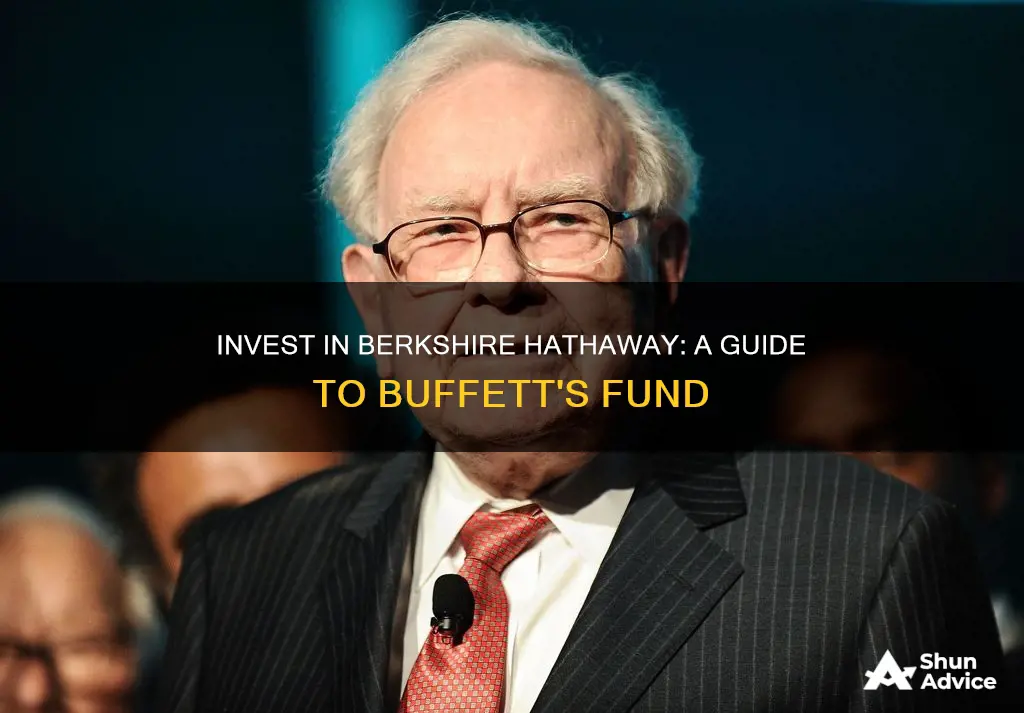
Warren Buffett's Berkshire Hathaway is one of the most famous public companies in the world. It has been a great long-term investment, outperforming the S&P 500 by nearly 2-to-1. The company has a large investment portfolio and owns operating businesses across insurance, railroad, utilities, energy, manufacturing, service, and retailing. Anyone can invest in Berkshire Hathaway if they have enough money to buy at least one Class B share (around $415 in mid-2024).
1. Evaluate Berkshire Hathaway's finances and determine if it makes sense in your portfolio: Start by reviewing the company's Form 10-K annual report and Form 10-Q quarterly reports to understand its financial health, competitive position, and risks. Also, consider the broader industry and competitors.
2. Decide on your investment goals: Determine if investing in Berkshire Hathaway aligns with your overall investment strategy. For example, if you are seeking dividend income, Berkshire Hathaway may not be a suitable choice as it does not pay dividends.
3. Choose between BRK.A and BRK.B shares: Berkshire Hathaway offers two types of shares. BRK.A shares are the original and highly priced offering, while BRK.B shares are more affordable and have the same proportional economic rights.
4. Pick a brokerage platform: Select a brokerage platform that meets your needs, such as low fees, the type of account you want, and the tools they offer.
5. Figure out how much you want to invest: Consider your budget, the current price of the shares, your investing strategy, and your other investments to determine how much you can afford to invest.
6. Open a brokerage account: Choose a broker that caters to your needs and open an account. You will need to fund this account to purchase Berkshire Hathaway shares.
7. Place your order: Use the ticker symbol BRK-B for Class B stock when placing your order. Decide on the number of shares or the amount you want to invest, and choose between a market order or a limit order.
8. Evaluate Berkshire Hathaway's performance: Regularly monitor your investment to ensure it aligns with your goals. Compare its annual rate of return with benchmarks like the S&P 500 and review its fundamental data over time.
| Characteristics | Values |
|---|---|
| Company Type | Holding Company |
| Founder | Warren Buffett |
| Current CEO | Greg Abel |
| Share Types | BRK.A and BRK.B |
| Share Price (as of July 26, 2024) | BRK.A - $657,180 per share; BRK.B - $437.66 per share |
| Annual Returns (since 1965) | 20% average annual returns |
| Dividends | Berkshire Hathaway does not pay dividends |
| Voting Rights | BRK.A - Higher; BRK.B - Lower |
| Convertibility | BRK.A shares can be converted to BRK.B; BRK.B shares cannot be converted to BRK.A |
| Investment Options | Individual shares, ETFs, or mutual funds |
What You'll Learn

Berkshire Hathaway's competitive position and financials
Berkshire Hathaway's Competitive Position
Berkshire Hathaway is a diversified holding company with subsidiaries in insurance, freight rail transportation, energy generation and distribution, services, manufacturing, and retailing. The company's insurance brands include GEICO and Gen Re, and its non-insurance subsidiaries operate in sectors such as confectionery, retail, railroads, home furnishings, machinery, and natural gas distribution. Berkshire Hathaway also holds stakes in prominent companies such as Kraft Heinz, American Express, Bank of America, The Coca-Cola Company, and Apple Inc.
Berkshire Hathaway's competitive advantage lies in its ability to generate high returns for its shareholders over the long term. From 1965 through mid-2024, the company delivered an 18.9% compound annual return, outperforming the S&P 500 by almost 2-to-1. This exceptional performance is a result of Warren Buffett's value investing principles, where the company retains profits to grow its operating platforms and investment portfolio.
Berkshire Hathaway's Financials
In terms of financials, Berkshire Hathaway has consistently demonstrated strong performance. For the third quarter of 2023, the company reported a total revenue of $93.2 billion, a 21.2% increase compared to the same period in 2022. However, due to losses on its investment and derivative contracts, the company's revenue dropped to $63.4 billion. The net loss attributable to shareholders rose to $12.8 billion in Q3 2023, and the company experienced a decline in its utilities and energy segment.
Despite the recent losses, Berkshire Hathaway has a strong track record of profitability. In the second quarter of 2024, the company's operating profit rose 15% to $11.6 billion, benefiting from higher insurance underwriting profits and increased interest income. Additionally, the company holds a significant amount of cash on its balance sheet, with a record $277 billion at the end of the second quarter of 2024.
Berkshire Hathaway's unique structure, with a diverse range of businesses and investments, contributes to its overall financial performance. The company's seven major business segments include insurance, freight rail transportation, energy, manufacturing, wholesale distribution, travel centers, and service and retailing.
Best Funds to Maximize Your 401k Returns
You may want to see also

Investment goals and portfolio fit
Before investing in Berkshire Hathaway, it is important to evaluate whether the company aligns with your overall investment goals and portfolio strategy. Here are some key considerations:
- Investment Objective: Ask yourself whether your primary goal is capital appreciation or passive income generation through dividends. Since Berkshire Hathaway has not paid dividends since 1967, opting instead to reinvest its earnings for growth, this stock is more suitable for those seeking capital appreciation.
- Risk Tolerance: Assess your risk tolerance and whether you are comfortable with the volatility associated with stocks. If you are investing in Berkshire Hathaway, be prepared to hold on to the stock during market downturns or even consider buying more if you believe in its long-term prospects.
- Diversification: Consider how Berkshire Hathaway fits into your overall portfolio allocation. Given that Berkshire Hathaway operates in diverse industries and has a large investment portfolio, it may already provide sufficient diversification. However, evaluate whether you need to balance your portfolio with other investments to manage your overall risk exposure.
- Time Horizon: Investing in stocks like Berkshire Hathaway typically requires a long-term perspective. Be prepared to hold the stock for at least three to five years to give your investment time to grow and weather short-term market fluctuations.
- Voting Rights: Decide whether voting rights are important to you. Berkshire Hathaway offers two classes of shares: Class A (BRK.A) shares have significantly more voting rights than Class B (BRK.B) shares. However, Class A shares are much more expensive, trading at a much higher price per share.
- Dividends: If you require dividend income as part of your investment strategy, Berkshire Hathaway may not be the right fit as the company has not paid dividends in several decades.
- Performance and Track Record: Evaluate Berkshire Hathaway's historical performance and track record. The company has consistently outperformed the S&P 500, delivering average annual returns of 20% since 1965. While past performance doesn't guarantee future results, this track record demonstrates the company's ability to generate strong returns over the long term.
- Investment Style: Consider whether you align with Warren Buffett's investment style and philosophy. Berkshire Hathaway follows a value investing approach, focusing on acquiring high-quality businesses at fair prices and reinvesting earnings for growth. If you prefer a different investment strategy, such as growth investing or dividend investing, Berkshire Hathaway may not align with your portfolio strategy.
- Tax Implications: Understand the tax implications of investing in Berkshire Hathaway, especially if you plan to buy and sell the stock frequently. Capital gains taxes may apply when you sell shares for a profit, and tax-loss harvesting strategies can be considered for losses. Consult with a tax professional for personalised advice.
Bond Mutual Funds: When to Invest for Maximum Returns
You may want to see also

How much to invest
When deciding how much to invest in Berkshire Hathaway, there are a few key considerations to keep in mind. Firstly, it's important to assess your budget and ensure that you are only investing money that you can afford to lose. This means setting aside funds for essential expenses and an emergency fund before allocating money towards investments.
Next, consider the current price of Berkshire Hathaway's Class A and Class B shares, as this will impact the amount of money you need to invest. As of mid-2024, Class A shares were trading at around $625,000 per share, while Class B shares were trading at approximately $415 per share.
Your investment strategy will also dictate how much you invest. If you plan to invest a large sum upfront, the amount you allocate will likely be different from someone who intends to invest smaller amounts regularly over time using a strategy like dollar-cost averaging.
It's also crucial to evaluate how Berkshire Hathaway fits into your overall investment portfolio and strategies. Diversification is essential to manage risk, so ensure that your investment in Berkshire Hathaway aligns with your other investments and financial goals.
Additionally, consider the volatility of the stock market and your risk tolerance. Stocks can fluctuate, so you should be prepared to hold your investment for at least three to five years to weather any short-term downturns.
Finally, when deciding on the amount to invest, keep in mind that it's generally recommended to keep the percentage of any single stock position between 3% and 5% of your total portfolio to minimise the impact of any one investment on your overall portfolio.
Hedge Fund Managers: Where to Find Their Investment Theses
You may want to see also

Choosing a brokerage platform
When choosing a brokerage platform, there are several factors to consider. Firstly, you need to decide whether you want an individual retirement account (IRA) or a taxable investment account. Not all platforms offer both options, so it's important to choose one that aligns with your financial goals.
Secondly, look for a platform that offers commission-free trading of U.S. stocks. Most major brokerages now provide this feature, but it's always good to confirm before opening an account. Additionally, consider what other offerings the platform provides to help you meet your financial and investment objectives. For example, some platforms offer fractional share investing, which allows you to invest in partial shares of a company, or tools to help you save and invest more effectively.
Another important consideration is the level of service and research provided by the brokerage platform. If you are a beginner investor, you may benefit from a platform that offers educational resources and customer support. On the other hand, if you are a more experienced investor, you may prefer a platform with more advanced tools and features.
Finally, consider the cost of using the platform. Some platforms charge higher fees than others, so be sure to compare pricing before making your decision. It's also worth noting that some platforms may offer promotions or incentives for new customers, so be sure to look out for those as well.
Once you've considered these factors, you can choose a brokerage platform that best suits your needs and preferences. Remember to review the terms and conditions carefully before opening an account and always do your research to ensure you're making an informed decision.
Alternative Investment Funds: A Guide to Investing in India
You may want to see also

Placing your order
Once you've decided to buy Berkshire Hathaway stock and opened and funded your brokerage account, you can set up your order. Use the company's ticker symbol – BRK-B for Class B stock, or BRK.B for Class B shares – when you input your order.
Most brokers have a ""trade ticket" at the bottom of each page, so you can enter your order. On the broker's order form, you'll input the symbol and how many shares you can afford, or the amount you'd like to invest if you're buying fractional shares. Then you'll enter the order type: market or limit. A market order will buy the stock at whatever the current price is, while a limit order will execute only if the stock reaches the price that you specify.
If you're buying just a few shares, you're likely best off sticking with a market order. Even if you pay a little bit more now, it won't affect the long-term performance much if the stock continues to perform well.
With dollar-cost averaging, investors add a set amount of money to their position over time, and that really helps when a stock declines, allowing them to purchase more shares. High-flying stocks can dip from time to time, so this strategy can help you achieve a lower buy price and higher overall profits.
If you want to make things simple, you can use a market order to buy your shares at the current price whenever you place your order. If you're a more sophisticated investor, or you only want to invest if you can buy shares at a certain price, then you might consider using a limit or stop-limit order, which only enacts trades when specific pricing conditions are met. Just know that when you do this, it's possible the stock may move away from the price you set as your limit, meaning you may not wind up with any shares.
Order placement
To buy shares of Berkshire Hathaway, you must have a brokerage account. If you still need to open one, here are some of the best-rated brokers and trading platforms, and a step-by-step guide to buying Berkshire Hathaway stock using Fidelity's five-star-rated platform.
Fidelity makes it easy to buy stocks. Its website offers a video tutorial and a step-by-step guide. Here's a screenshot of how to place a stock trade with Fidelity.
On this page, fill in all the relevant information, including:
- The number of shares you want to buy or the amount you want to invest to purchase fractional shares.
- The stock ticker symbol (BRK.B for Berkshire Hathaway).
- Whether you want to place a limit order or a market order. The Motley Fool recommends using a market order, as it guarantees you buy shares immediately at the market price right at that moment.
Once you complete the order page, submit your order and become a Berkshire Hathaway shareholder.
UK Pension Funds: Where Is Your Money Invested?
You may want to see also
Frequently asked questions
BRK.A is the original stock offering from Berkshire Hathaway and is known for its high price per share. BRK.B shares were introduced in 1996 and are more affordable for small investors, but they have fewer voting rights.
This depends on your budget and investment strategy. BRK.A shares are very expensive, so you will need to have a large amount of money to invest. BRK.B shares are more affordable and allow you to buy a smaller slice of the company.
You will need to open a brokerage account and decide on the type of order you want to place (market or limit). Then, use the company's ticker symbol (BRK-B for Class B stock) to place your order.
Berkshire Hathaway has a long history of outperforming the market and providing strong returns for investors. It is a well-diversified company with a wide range of businesses and investments. However, it does not pay dividends, so if you are looking for passive income, this may not be the right investment for you.
It is important to do your due diligence and evaluate the company's financials and competitive position. You should also consider your own investment goals and whether Berkshire Hathaway aligns with them. Additionally, you should determine how much you can afford to invest and be prepared to hold the stock for at least three to five years.







